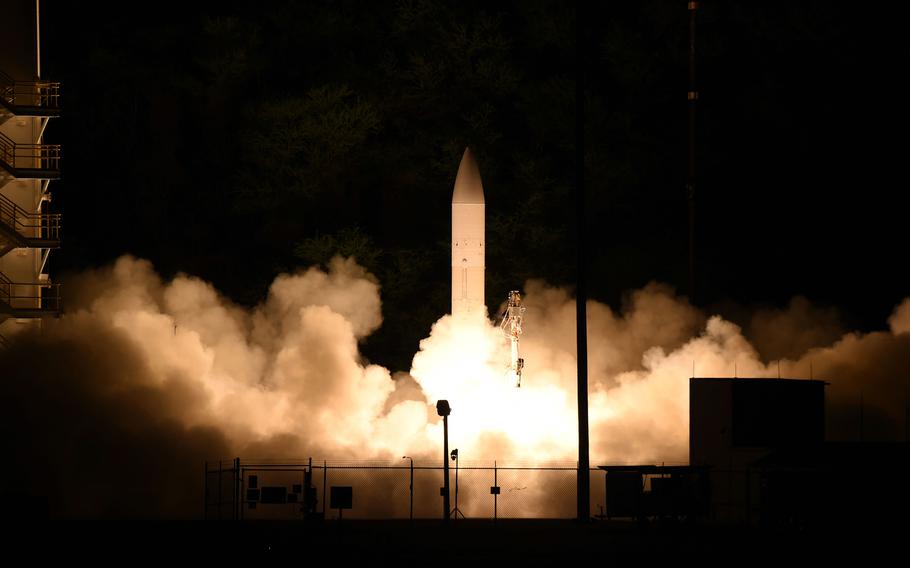
A hypersonic glide body launches from the Pacific Missile Range Facility in Kauai, Hawaii, March 19, 2020, during a Department of Defense flight experiment. (U.S. Navy)
FORT SHAFTER, Hawaii — The Navy intends to significantly increase the level of training on Kauai and an uninhabited island that would exponentially step up the tempo of missile and rocket launches, amphibious and drone operations and airport use by helicopters by the joint force.
The Navy laid out its plans for the Pacific Missile Range Facility on Kauai in a draft environmental assessment issued in August.
The plan would increase the frequency of 13 types of training and testing activities that take place on the Barking Sands installation on Kauai and on Kaula, an uninhabited Hawaiian island to the southwest.
Barking Sands lies on a coastal strip on the west side of Kauai and is part of a missile range with an operational area that includes more than 1,100 square miles of underwater range and more than 42,000 square miles of controlled airspace, according to the Navy.
The range is capable of simultaneously supporting surface, underwater, air and space operations.
The Missile Defense Agency routinely uses the range for testing ballistic missile prototypes.
Under its proposed plan, the Navy would continue using the range as it has in the past but increase training and testing conducted by the Army, Air Force, Marine Corps and the Missile Defense Agency.
“Training and testing activities may also include the participation of foreign militaries under U.S. sponsorship and oversight,” the draft assessment states.
The assessment concludes that the added activities would not significantly affect air quality, climate change and greenhouse gases, noise, public health and safety and biological and cultural resources,
The Navy is not proposing new types of training or testing at Barking Sands or Kaula, a 135-acre crescent-shaped isle about 55 miles southwest of Kauai.
Kaula would see increases in air-to-ground bombing exercises, and air-to-ground gunnery exercises.
About 11 acres in the south of the island is used for those exercises. Live fire is prohibited on Kaula.
The number of bombing exercises, which involve training of strike fighter aircraft delivering inert ordnance on the island, would increase from 12 to 31.
In gunnery drills, strike fighters and helicopter crews use guns and inert rockets to attack the island. Those exercises would increase from 14 to 24 per year.
Some activities on Kauai would increase far more dramatically, in certain cases by more than 2,100%.
Among the plan’s expected annual increases for activities are:
• Drone and counter-drone operations, from two to 45, a 2,150% increase.
• Movements by units over land to new locations, from one to 22, a 2,100% increase.
• Helicopter and Osprey landing-zone operations at airport, from one to 12, a 1,100% increase.
• Establishing and operating tactical field command posts, communication systems, radar tracking and surveillance systems, optical tracking systems and electronic warfare equipment, from nine to 70, a 678% increase.
• Amphibious operations, from four to 26, a 550% increase.
• Launches of missile, rockets and aerial-target drones, from 25 to 35.
• Non-live fire missile or rocket system launch preparations, from one to six.
• Establishing and operating forward arming and refueling points for fighter jets, helicopters, cargo planes and Ospreys, from one to 20.
The Navy’s plan was developed with the joint services and the MDA “to identify training and testing activities that were not being supported at other locations and for which [the missile range] was already supporting due to the availability of facilities and range assets,” the assessment states.
Then, taking into consideration factors such as safety, range capability and test scheduling, the Navy determined the tempo of training and testing activities the range could support into the “reasonably foreseeable future,” the assessment states.
The draft assessment is posted at www.pmrf-kpgo-eis.com/media/2lspojsq/pmrflbtdraftenvironmentalassessmentaugust2024.pdf.
A final environmental impact statement is expected to be released next year for public review and comment.